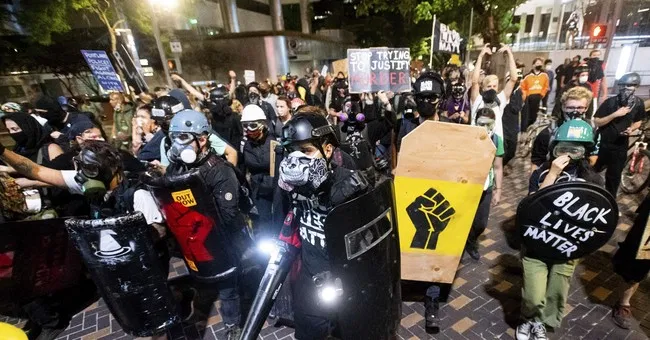
Sounds like The NY Times may have just discovered Antifa in Portland, so we wanted to take note of that fact.
Also they’ve discovered Antifa has moved into harassing people in residential neighborhoods.
NYT: “The marches in Portland are increasingly moving to residential and largely white neighborhoods, where demonstrators with bullhorns shout for people to come ‘out of your house and into the street’ and demonstrate their support.”https://t.co/H4JLfL8uQd
— Josh Kraushaar (@HotlineJosh) September 21, 2020
“The more personal tactics echo those being used against elected officials, with activists showing up not only outside mayor’s offices but their homes as well.”https://t.co/H4JLfL8uQd
— Josh Kraushaar (@HotlineJosh) September 21, 2020
Now of course Antifa has been in residential neighborhoods for months bothering people and the Times is identifying these people as “protesters against police brutality.” But they do mention Antifa in the story and how Antifa in black bloc are involved. So we welcome the Times for finally catching up to at least part of the story.
It’s funny reading their story and knowing the actual facts. You can see how critical information is missing and the radical nature or violence is played down. Imagine the stories they run where you don’t know the facts.
But even as they downplay it, they still manage to let a little of the crazy behind the group slip out.
One resident, Terrence Moses, described what happened when they hit his street in Portland, according to the Times.
Mr. Moses was initially not sure what the protesters were upset about, but as he got closer, he saw it: His neighbors had an American flag on display.
“It went from a peaceful march, calling out the names, to all of a sudden, bang, ‘How dare you fly the American flag?’” said Mr. Moses, who is Black and runs a nonprofit group in the Portland, Ore., area. “They said take it down. They wouldn’t leave. They said they’re going to come back and burn the house down.”
Mr. Moses and others blocked the demonstrators and told them to leave.
“We don’t go around terrorizing folks to try and force them to do something they don’t want to do,” said Mr. Moses, whose nonprofit group provides support for local homeless people. “I’m a veteran. I’m for these liberties.”
The New York Times described this action as “more confrontational” and “personal,” targeting ordinary people, demanding they get out of their houses and into the streets. Yes, that’s one way to describe threatening to burn down someone’s home.
“We don’t need allies anymore,” said Stephen Green, an investor and entrepreneur in Portland who is Black. “We need accomplices.” What an appropriate legal term. But he said he was “down to make my neighbor uncomfortable.” The couple who Antifa threatened is still worried they may come back and burn down their house after they found their phone number, but they’re not taking their flag down.
The Times describes about 200 ‘protesters’ meeting for a ‘direct action’ march in a park.
They gathered in an unlit park in a residential neighborhood around 8 p.m. Everyone wore black, including some protesters who had on body armor and motorcycle helmets. They hastily set up picnic tables and supply booths in the dark, using cellphones for light to showcase their goods. There was a food table overflowing with protein bars and Monster energy drinks.
A small free literature selection was set up on the grass and overseen by three people in ski masks. It was a popular offering, and people crowded around, craning to see the pamphlets.
Titles included “Why Break Windows”; “I Want To Kill Cops Until I’m Dead”; “Piece Now, Peace Later: An Anarchist Introduction to Firearms”; “In Defense of Smashing Cameras”; and “Three-Way Fight: Revolutionary Anti-Fascism and Armed Self Defense.”
The energy was something like a carnival in the dark.
“Paint balloons, get your paint balloons,” someone barked.
Peaceful protest, right? Just sharing a little information about committing crimes and killing cops.
They made sure they went to a mostly white neighborhood. One guy clapped for them and they asked him to join them. He waved them on and they called him spineless.
He looked worried. But the march moved along, and he went back into his house.
“You’ll never sleep tight, we do this every night,” the protesters chanted.
They will force you to agree. Or you wouldn’t ever sleep.



